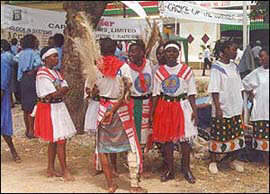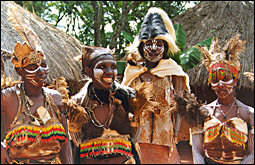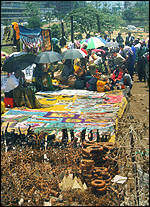 PEOPLE PEOPLE |

Kenya is a real melting pot of different nationalities, tribes and ethnic groups making it a tolerant, accepting and colorful country. It currently has a population of about 26 million people which include over 40 ethnic groups.
 TRIBAL GROUPS TRIBAL GROUPS |
 Akamba Akamba |
Recognized worldwide for their skill in wood carving
 Gusii Gusii |
Live in the rich highlands east of Lake Victoria
 Kalenjin Kalenjin |
They are closely related to the Nandi, and are good long distance runners. President Moi is a Kalenjin himself. They inhabit Western Kenya, and although they were mainly pastoralist, they have started to develop agricultural skills. Today the area around Eldoret, where they live has become an important producer of agricultural products which are even exported abroad,
 Kikuyu Kikuyu |

The most numerous and close kin to the Embu and the Meru. They are probably the largest ethnic group. The Kikuyu inhabit central Kenya (Mt. Kenya, the Lake district and Nairobi). They are entrepreneurial business people, having lost many of their traditions while fast adopting the western style of living. The famous Mau Mau secret society of warriors came from this indigenous group, and for years scared white settlers away while fighting for their independence claiming their lands back.
 Luhya Luhya |
Occupy the three western districts, near Kakamega. They do not include circumcision in their rite of passage, however, they eliminate the two lower frontal teeth during this ceremony.
 Luo Luo |
Inhabit three districts bordering Lake Victoria.
They are quite large, friendly, and have darker
skins than other tribes. Their main activity is
fishing and farming, and their traditional dress
is most decorative: body ornamentation together
with colorful feathers, hippo tusks and metal embellishments
make Luo dancing and festivals an eye-catching scene.
In their initiation rites they remove their 4 lower
front teeth. |
 Maasai Maasai |

Are so named because they speak Maa and despite not being numerically strong, they are nevertheless Kenya's best known tribe. They have a deep involvement with their cattle, since cattle represents wealth but also food (milk, blood, and meat), it provides leather for sandals and beds and is currency for marriage, fines and sacrifices. They were known in the past for having been fierce warriors. In fact, in the old times, one of the trials during their rite of passage of young warriors (known as Maasai moran) was to kill a lion. They have not changed their way of life for centuries.
 Nandi Nandi |
Closely related to the Kalenjin they come from Western Kenya, around Mt Elgon. From this tribe come some of the greatest long distance runners of all times. It is not unusual to find Nandi runners in the highest positions of the podiums in international athletic events such as the olympic games
 Samburu Samburu |
Are cousins to the Maasai and live in a large district north of the equator where they herd cattle
 Swahili Swahili |
These are the people from the coast. They are a beautiful blend of Arabs and Africans. They are muslims, have lighter skin than in the rest of the country and their women are veiled. Their architecture has a marked Arabic influence. They are merchants and sailors.
 Turkana Turkana |
Live in an arid sun-scorched land almost as inhospitable as land in use can be. Their district is of great size and lies to the west and is bordered by, Lake Turkana. Their crafts utilize the materials of the area which include leather, seeds, shells, horns, bones and stones.
 CAUCASIAN CAUCASIAN |
There is quite a large population of white Kenyan descendants from the colonial era. They consider themselves first and foremost Kenyans and then British, since they were born and raised in the country and have been here for more than 3 generations. President Jomo Kenyatta offered them the nationality knowing how relevant for the economic development they were. Most of them are important businessmen. There is also a considerable amount of expatriates working for international institutions in Kenya.
 ASIAN ASIAN |
That is the way most Kenyans refer to Indians. They have been here since the building of the Kenyan railway and today make up a relevant part of the country's population. Most hold top business positions but few are politically involved. |

